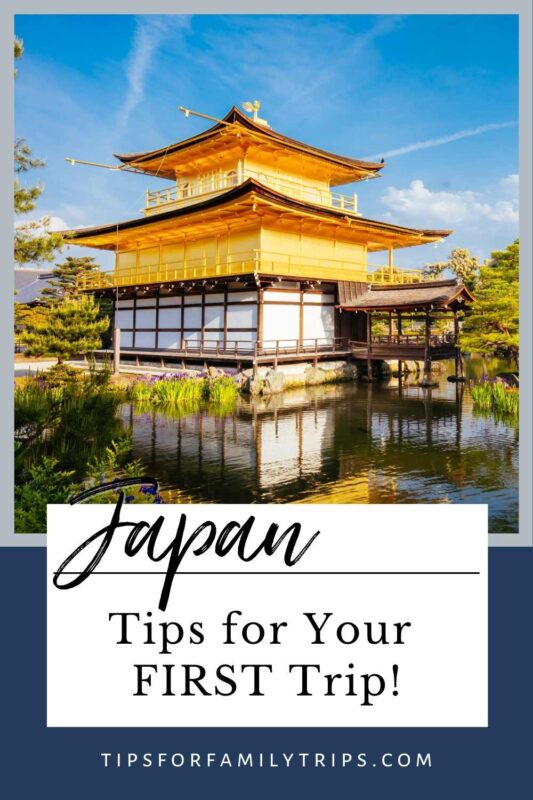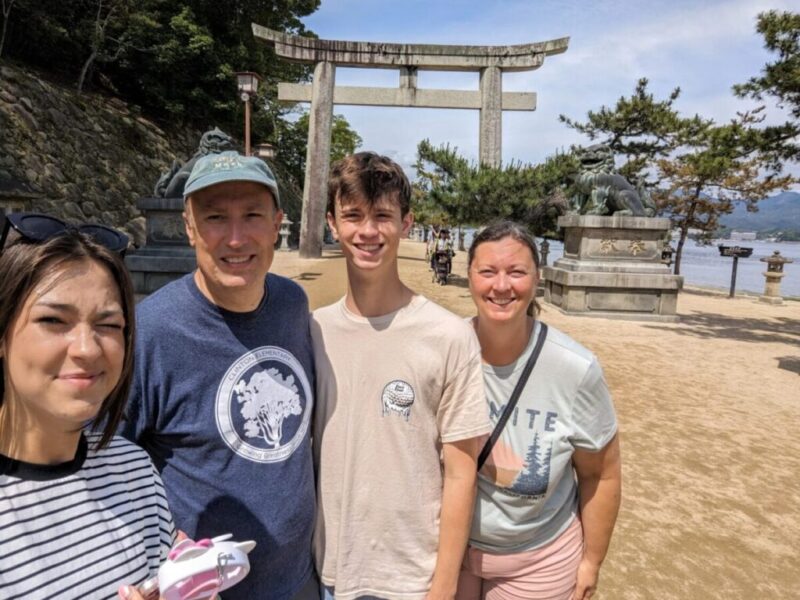Hello! Are you planning a trip to Japan? Feeling overwhelmed?
I know how you feel!
My family of four spent two weeks in Japan in early June 2023. My kids were ages 16 and 19. We visited Tokyo, Hiroshima, and Kyoto. We had a wonderful time and made irreplaceable family memories together.
We crammed a lot into our trip, including TeamLab Planets, Shibuya Crossing, Harajuku, Tokyo Disneyland, DisneySea, Asakusa, Shinjuku, Ghibli Museum, SkyTree Tokyo, Hiroshima Peace Museum, A-Bomb Dome, Miyajima, Monkey Park, Bamboo Forest, Nijo Castle, karaoke, outdoor markets, modern malls, and many beautiful temples and shrines.
For me, planning a trip to Japan was challenging. This was our first trip to Asia. None of us was familiar with the language, geography, culture, climate, etc., and there were a lot of practical details to figure out.
Fortunately, there is abundant information online (including this article!), so it's easy to get answers to all your questions – including questions you didn't know to ask. We found the Japan Travel Tips and Planning group on Facebook to be especially helpful.
Here's an overview of important things you need to know before you go to Japan. It includes answers to our biggest questions and tips to help you plan your trip faster.

Connectivity
Access to Google Maps and the internet were ESSENTIAL throughout our trip to Japan. They helped us easily navigate the complex public transit systems, access apps and tickets for attractions, and get the information we needed when we needed it.
Make sure you have a plan to stay connected. There are several options.
- We rented a pocket Wi-Fi device from Japan Wireless for about $5 per day. We chose this option because it covered all our family's devices for the lowest price. Sometimes service was spotty, but it mostly worked well. We booked online in advance and then picked it up and dropped it off at the airport. There are other providers, but Japan Wireless worked for us.
- A pre-paid SIM card replaces your regular SIM card while you are on the trip. It connects you to a local wireless service and gives you full access to your phone's features. Japan Wireless offers SIM cards too, as do other providers.
- The easiest option is probably the phone plan you already have. T-Mobile welcomed us to Japan as our plane landed and offered us connectivity for about $5 per phone per day. We were using pocket Wi-Fi, so we turned off our roaming service during our trip. Look into your plan's options before you leave home.
All our hotels and some public places had free Wi-Fi, but Tokyo is the biggest city in the world. We visited unfamiliar neighborhoods every day and got on the wrong train more than once. Some attractions have apps and digital passes that you can only access on a phone. I am glad we are traveling in a time when we have constant, reliable access to the Internet because it makes things so much easier!
Related: Our Two-Week Japan Itinerary
Money
The yen is the official currency of Japan. As of June 2023, the dollar is strong against the yen and we found most things in Japan to be less expensive than in the United States. For example, many of our meals cost the equivalent of $7-10 per adult.
There are a few good ways to pay for things in Japan.
- Credit Card – Visa and Mastercard are accepted in most places, but not everywhere. We used our credit cards whenever we could because Visa and Mastercard will always get the best available exchange rate. Look for the Visa or Mastercard logos to know where they are accepted.
- Cash – You need yen in cash in Japan. You can't recharge your Suica (public transit) card without cash. Some restaurants and shops only take cash, and this is usually posted at the entrance.
- Suica – Suica works on all the public transportation we used. It can also be used at vending machines, convenience stores, and other places. We occasionally used Suica instead of cash when Visa was not accepted.
We used about 100,000 yen in cash (currently $700+ USD) during our 2-week trip. We mostly used it to load our Suica card, for a few meals, and other small expenses.
We exchanged $500 for yen at our bank before we left home. It was convenient to have cash when we arrived, but the exchange rate wasn't great.
ATMs at 7-11 convenience stores are a better option for getting cash and they are easy to find – even at Haneda Airport (and probably Narita too). These ATMs offer a good exchange rate and do not charge fees. I opened a Capital One checking account before our trip because it does not charge out-of-network ATM fees either.
Search “yen to USD” online to convert yen amounts to U.S. dollars at the current exchange rate. This was a handy tool before and during our trip.
Related: Tips for Exchanging Currency for an International Trip
Transportation
We used public transportation during our two weeks in Japan and it worked well. Buy a Welcome Suica card or a regular Suica card at an airport machine if your trip is based in Tokyo and other large cities. There are other cards (like Pasmo) that work the same way, but Suica worked well for us in Tokyo, Hiroshima, and Kyoto.
The Welcome Suica is a 28-day card designed for visitors. It has no deposit and you will not get a refund if it still has money on it at the end of your trip, so pay close attention to the balance. You need Japanese yen to purchase a Suica card. We started with 2,000 yen per person and added 1,000 more every 2-3 days.
The Suica card can also be used at vending machines, convenience stores, and other places. We each used it 1-2 times a day to buy water bottles and soda for 100-200 yen per bottle. I also used it on the washing machine at our first hotel.
Consider a JR (Japan Rail) Pass if you will be taking multiple trips on the Shinkansen (bullet train) to other cities during your stay. The JR Pass is good for unlimited trips on the Shinkansen and local JR transportation lines. It's smart to do the math to find out if the JR Pass or buying individual tickets is the better deal for your trip.
We walked 15,000-20,000+ steps most days. Walking is the best way to experience Japan, so pack at least 2 pair of comfortable, broken-in walking shoes.
Do you need a Suica card if you have a JR Pass? YES.
In our experience, most subway trains, buses, and street cars did not take the JR Pass unless they were specifically labeled “JR”. We used the JR Pass to get from Tokyo to Hiroshima to Kyoto and back to Tokyo. We got a 7-day JR Pass and activated it for the last 7 days of our trip when we were traveling outside Tokyo.
Does each person need their own Suica card or JR Pass? YES.
You tap in and out with the card at the beginning and end of every trip. The same card cannot be used for two people. The automatic gates will freak out if you tap in or out twice. Children under age 12 pay less per ride, so purchase a Child Suica for them.
Related: What Does a Trip to Japan Cost?
Hotels
I was overwhelmed by all our hotel choices in Tokyo. It's a huge city with thousands of hotels! And Japanese hotels are not always the same as U.S. hotels.
Here are a few tips for picking a good hotel.
- Consider booking more than one room. Tokyo hotel rooms are often smaller than American hotel rooms. With teens, we booked two rooms with two twin beds, and it worked well. If your children are young, look for larger “family” rooms and suites.
- Choose hotels that are close to train stations. We used those stations a lot, and closer was better. Use Google Maps to map the route from a hotel to the station and to your main activities before you commit. Keep in mind that Google Maps may also direct you to bus stops and alternate stations, depending on where you are going.
- Choose hotels that are close to your activities – It can take 30-45 minutes to get from one Tokyo neighborhood to another on public transportation. You'll want to do that sometimes, but it's smart to strategically choose a hotel in a fun neighborhood near some of your major activities. Then look for other activities near your hotel.
- Consider uniquely Japanese lodging – We stayed in a capsule hotel in Hiroshima and a ryokan (traditional guesthouse) in Kyoto. We were basically sleeping on pads on the floor at both, but I'm so glad we tried them!
- Use a hotel booking site – I usually prefer to book hotels on official websites, but most Japanese websites did not translate well for me. Agoda.com and Booking.com were helpful in finding the hotels and specialty lodging we wanted.
Our capsule hotel was only for adults and older teens (16+). Men and women sleep on different floors. We got “premium” capsules for about $25-30 per person for one night. Aside from the hard bed, I LOVED this experience. It was very quiet and we all got the “alone time” we were craving.
At our traditional ryokan in Kyoto, we slept on futons on the floor. We took off our shoes at the door. We had a private bathroom and the option of using the public onsen (bath) – separated by gender. Breakfast and dinner were available and optional.
Japanese hotels typically provide pajamas (one size), slippers, toothbrushes, toothpaste, shampoo, conditioner, body wash, razors, and other hygiene supplies for no additional charge. Items vary by hotel. Laundry facilities were available at most of our lodgings.
Related: Tips for Choosing a Hotel Location
Activities
Activities is a huge category that will be different for everyone, so I'll keep it short and general. Here are my top tips for planning activities in Japan…
- Do you need a reservation? Many popular activities like Ghibli Museum, Tokyo SkyTree, Tokyo Disney Resort, TeamLab Planets, and others have limited admission and require or recommend reservations. Find out when reservations open and mark it on your calendar. The opening dates and times are on Japan Standard Time, so look up what time that is where you live.
- Try Klook. Klook.com is an Asia-based travel website like Expedia or Viator where you can book activities, hotels, and more. At the time of our visit, the official Tokyo Disney Resort website did not accept U.S. credit cards, so we bought our Tokyo Disneyland and DisneySea tickets through Klook for about the same price. We also bought our JR Passes through Klook when I couldn't figure out which JR Pass website was the official website.
- Don't overschedule – We walked 15,000-20,000+ steps every day in Japan. I was EXHAUSTED at the end of every day – and sometimes at the beginning too. It's hard to say what I wish I'd skipped, but give yourself some flexibility and downtime every day. Make adjustments when your family is too tired to enjoy the experience.
- Mix it up – Make sure your itinerary has variety. Near the end of our trip, we were not excited about walking around another temple – no matter how spectacular it was. So, we made major changes to our Kyoto itinerary on our last day. We took a scenic train trip, tried karaoke, went shopping, and sampled a lot of delicious foods. We felt relaxed, had fun, and finished our trip on a high.
It was easy to get reservations at most places. But if Ghibli Museum is your dream, all tickets for the month will be gone within minutes. We successfully got Ghibli Museum tickets by joining the queue early, having backup dates/times ready, and having a little luck. We were not so lucky for the Imperial Palace Garden Tour or the Kirby Cafe in Tokyo.
Related:
Food
Japanese food is delicious! We ate sushi, ramen, udon, tempura, gyoza, okonomiyaki (savory pancake), karaage (fried chicken), Wagyu beef, crepes, taiyaki (cream-filled pastry shaped like a fish), mochi, ice cream, shaved ice, and more.
My husband and daughter will eat anything and they loved eating in Japan. I don't like seafood, but I had no problem finding good pork, beef, and chicken dishes.
My teen son is a vegetarian and we had a hard time finding good meals for him. Japanese food is usually meaty and we don't speak enough Japanese to make special requests or ask questions.
Since his diet is a preference and not an allergy, there were times when he ordered the tofu ramen and didn't ask questions about the broth. Okonomiyaki (savory pancake) was a good regional dish for him in Hiroshima and Kyoto because it can easily be prepared without meat or fish powder. Eggs are used a lot in Japanese food and were a good option for him.
If you have a food allergy, sensitivity, or special diet, here's what worked for us.
- Research restaurants and dishes online in advance. We were most successful when we already knew where to find vegetarian restaurants near planned activities. The Happy Cow app was helpful sometimes, but not always.
- Carry a printed food allergy card. There are lots of resources online.
- Use convenience stores. 7-11, FamilyMart, and Lawson's are on every corner in the cities we visited. They have a variety of hot and cold foods to supplement special diets. We ate breakfast and snacks from convenience stores every day.
One more thing… It's a good idea to practice eating with chopsticks before you leave home if you are not already proficient.
What to Wear
We observed that most Japanese women – young and old – wear long, loose clothing in the summer. They dress more conservatively and less casually than in the United States. Many women wear modest dresses and skirts with sneakers or dress shoes. Many women in Tokyo were elegantly styled, whether they wore a dress or jeans and a T-shirt. Most women do not wear shorts, tank tops, leggings, or athleisure.
Most men in Japan also dress more conservatively and less casually than in the United States. We did not see many men in shorts or hats. Long pants with T-shirts or button-down shirts were the norm.
Ultimately, wear whatever is comfortable for you. That's what many tourists in Japan do, and if you are not ethnically Japanese, you won't blend in anyway. We saw lots of styles and we felt comfortable in the casual clothes we packed – especially in Kyoto which felt more touristy and less fashionable than Tokyo.
Language
English speakers can get by in Japan's major cities without knowing much Japanese. Most signs are in Japanese and English. Most people we met spoke enough English to do their job. Many hotel, restaurant, and transportation services are automated so you don't always need to communicate with a person.
I only met two people (both in Hiroshima) who spoke English fluently. There were probably others, but we did not make special requests or ask questions because it always felt like a long shot. I felt like it was rightfully my problem that I couldn't communicate well.
I regularly used the Lens photo translator on my Google Pixel phone to translate written Japanese signs and menus. I rarely used my Google Translate app to communicate verbally.
Nearly everyone we met in Japan was kind and helpful. The one Japanese word we used frequently was “arigato,” which is one way to say “thank you.”
Electrical Outlets
Different countries use different electrical outlets and voltage. You often need a plug adapter and voltage converter when you travel internationally. It's easy and relatively inexpensive to buy these items on Amazon.com.
Japan uses two-prong outlets, similar to the United States. Voltage in Japan is 100 V. In the U.S., it is usually 120 V.
They are pretty close and, depending on your electronics, you might not need adaptors. I don't have a strong understanding of electricity and for me, the advice on the internet was fuzzy on this.
However, if each person in your family needs to charge a phone, pocket Wi-Fi, iPad, earbuds, portable charger, etc. every night… you might want to buy a plug adaptor that can charge them all at the same time.
I bought this U.S. to Japan plug adapter on Amazon and it worked well for us. I bought a two-pack, which was helpful in Tokyo when we had two rooms. Even in one room, it gave us the capacity we needed.
Bathrooms
Japanese toilets are legendary – and for good reason. Most have seat cleaning spray, heated seats, sound effects for privacy, and 3-4 bidet buttons for cleaning yourself afterward. The only downside is that some toilet stalls are really tiny for tall people.
AND… all our lodgings had separate shower/bath rooms where the tub was deep and the whole room was the shower. Americans could learn a lot from Japanese bathrooms. We are missing out.
Public bathrooms are generally easy to find in Japan. They are all marked the same way. In the cities we visited, “Western” toilets with all the buttons are the norm, but we saw a few squat toilet stalls as well.
Weather
We visited Japan in early June. The rainy season starts in May, so we packed umbrellas and rain jackets. Most days were just cloudy, but we used our rain gear a few times. It was humid and warm every day. Many Japanese women use umbrellas in sunny weather.
Spring is cherry blossom season and fall has colorful leaves. Both those seasons are less rainy and humid than summer. So, visit in spring or fall if you have the option.
Safety
We always felt safe in Japan. If there are “bad” or unsafe neighborhoods, we never saw one. We saw no homeless people. Nobody acts strangely on the subway. Everyone speaks in low voices and minds their own business. Subways, buses, train stations, streets, and public bathrooms are clean and quiet by American standards.
Earthquakes are common in Japan. Typhoons may occur in the summer. We did not experience either of these during our visit. I understand that the locals just ignore most earthquakes because they are used to them. A typhoon warning temporarily disrupted travel the week before our trip.
It's smart to use the same safety precautions in Japan as you would anywhere else in the world, but Japan is probably one of the safest places you can visit. I recommend buying travel insurance before every big trip.
Related: Tips for Buying Travel Insurance

Conclusion
Japan is an amazing place! It was a dream trip for my family, even though it was a lot of work to plan. We made a few rookie mistakes, but they were minor. Our plans mostly went pretty well.
If you are planning a trip to Japan, all your research before the trip will be helpful, even if you don't use it all.
I hope that our experience helps you plan a great first trip to Japan! If you have a question or another tip to add, please share it in the Comments below.
Happy travels!













Mary Beth Hein
Would you be able to share your 2 week Japan itinerary with us? Including hotels and restaurants?
Allison
Hi Mary Beth! I shared our itinerary with my email subscribers, and if you are interested in subscribing, I’ll be happy to send it to you too. The subscription is free and no-commitment. Just hit “reply” to any email from me and remind me to send you our Japan itinerary. 🙂 Here is the link to subscribe: https://tipsforfamilytrips.lpages.co/dream-trip-starter/
801mom
Perfect we are planning a similar trip for next summer!! Thx